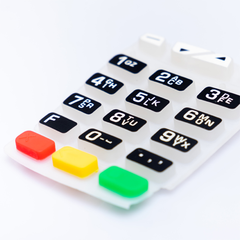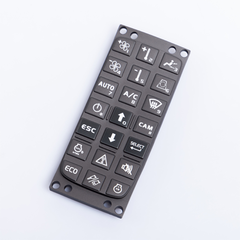Contact
Write to Us And We Would Be Happy to Advise You.
Do you have any questions, or would you like to speak directly with a representative?
By hqt
Undoubtedly, professional rubber keypad membrane is the perfect complement to any housing. Your device gains its character and at the same time increases its functionality. They make of specially prepare films, most often polyester. As a result, the foil keypads are resistant to chemical reagents and the remarkable mechanical resistance.
An additional advantage is that the foil keypad is hermetic, and therefore resistant to damage causes by water or dust. The applied graphics are visible through a thick coating, thanks to which it will remain resistant to mechanical damage such as scratches or abrasion during the use of the product for a long time.
What is the structure of membrane keypad?
The production technology allows you to adjust the rubber keypad membrane to the individual specifics of individual devices, not only in terms of the graphics used, but also the key embossing patterns, colors, foil texture, as well as the shape of the structure itself.
Certainly, the original and carefully design and made membrane keypad will increase the attractiveness of the product. We are all aware that “the customer buys with his eyes” and this also applies to technical, more specialized devices.
This allows to significantly reducing the costs of preparing the production as well as manufacturing, especially compare to the production costs of other types of rubber keypad membrane.

Rubber keypad membrane or foil keypads are a very popular technological solution, valued for their durability, small thickness, as well as favorable price and interesting aesthetics. The small size allows them to be easily adapted to the device housing.
They uses in industry (also in machines operating in a highly pollute environment), automotive, and as switches in building automation systems.
The rubber keypad membrane consists of many layers of foil. The outer layer – made of polyester or polycarbonate – design to protect its interior against environmental activities.
The imprint with icons, letters or numbers is on the inside, so it is not damaged due to intensive use. The tracks and contact pads imprint on the polyester foil contact.
The signal flow after pressing the key, depending on the design, causes by contact of the printed layers of foil or a metal element with the foil – then the system is galvanic ally short-circuited. The individual layers join using adhesive-coat fixing and spacer foils.
This design makes the keypad resistant to mechanical damage, as well as weather conditions, dust, water and many chemical compounds. Thanks to this, membrane keypads work well in places where a standard mechanical keypad will be quickly damage.
These products is easy to make in versions without a perceptible “click”. The first of them are characterized by a longer service life.
The most frequently uses rubber keypad membrane is the flexible membrane keypad, which uses permanently even in special working conditions. The surface consists of polyester films which are usually thermoform or embossed. In addition, production is inexpensive as no separate buttons require and an individual button mechanism not require.
For use in a dusty environment (e.g. in industry), the foil and normal keypads sometimes combine in such a way that the keys of a normal keypad support the rubber keypad membrane underneath.
The membrane keypad is the outer closure of the dust-proof housing. Circuit layers print on polyester substrates using special silver, carbon and insulating inks.
Additional protection against oxidation comes by printing with the use of carbon. There are different techniques, so for example metal snap domes that mount under the foil or so-call using the polydome technique, with the whole consisting solely of extruded foil.
There are other techniques, such as no stamping and no metal domes. The key design usually prints on the back using a screen printing process.

The rubber keypad membrane mainly uses where its resistance to dirt and water is important, or ease of cleaning require, or where a compact design or inexpensive production only for occasional use is important.
They use to control machines in industry or as keypads in industrial computers, medical devices, disinfection applications and electrical household appliances, as well as peripherals for computers, remote controls and mobile phones. The price depends on the parameters of the device.
If you are still not sure which keypad will work best for you, take a look at your individual preferences. Choose the membrane option if you only use your computer from time to time, or you most often watch a lot of movies and series on it, or use it to browse the web.
This keypad will work best for people who do not use it for many hours of typing or games.
For players and people who work with the written word, a rubber keypad membrane is a much better choice. It will ensure not only greater durability and convenience of use, but also precision. Mechanical models have more ergonomic shapes, perfectly adapt to the user, increasing comfort during many hours of sessions. The layout and size of the keys impact on the shape.
In some models you can find islands and stands, relieving the wrists during work. If you don’t know which rubber keypad membrane is best for you, head to a hardware store and see which one is the most comfortable for you.
Do you have any questions, or would you like to speak directly with a representative?